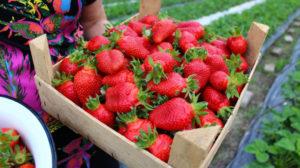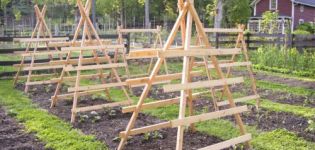How often should strawberries be watered during berry ripening and fruiting
In order not to be mistaken, figuring out how often and abundantly to water strawberry bushes, you should know the rules for caring for this crop. In addition to using water, it is possible to use liquid fertilizers, growth stimulants. Flowering and fruiting periods require the opposite approach, while observing the drinking regime. The climatic zone and the season are also influenced. Having an understanding of these subtleties is extremely important.
Strawberry watering rules
To ensure a regular supply of juicy, fragrant strawberries to the table, to get a stable harvest, you need to properly water the bushes. The culture is specific, with a peculiar structure of the root system and water regime.
Most gardeners are aware that strawberries "drink" a lot of water, but few know that overflow is more dangerous for them than drought.
The roots are divided into superficial ones that absorb moisture from shallow soil layers and long roots located in the lower horizons of the soil. Both those and others eat separately.
The task of the summer resident is to ensure a uniform flow of liquid along the height of the earthen cake, avoiding waterlogging, stagnation.
How often and with what to water strawberries for a high harvest
Watering watering strife. There is a drinking regime for strawberries in dry weather, but there are also rules for rainy seasons. The plant experiences a special need for liquid from May to September, during the period of active growth and fruiting.

Until the heat comes, at the beginning of the growing season, the frequency of watering is once every 7 days. Changing the temperature upwards requires adjusting the "water procedures": 2-3 times a week. The type of soil, in turn, also affects the frequency and amount of moisture for feeding strawberries. Strawberries on sandy soils with high drainage need to be moistened every 2 days in summer. With the arrival of autumn, watering is gradually reduced so as not to cause putrefaction in the soil and the underground part of the plant.
If it rains, the soil receives enough natural moisture, no additional feeding is needed.
Particular attention is paid to water temperature. Watering with cold liquid stimulates the development of rot, leading to the death of the bushes. It is recommended to settle the water in barrels or tanks, and only then gently "water" the strawberries, avoiding drops on the leaves. There is no time to painstakingly water each bush from a bucket, watering cans - you can adapt the watering hose to the storage tank, it is not difficult.
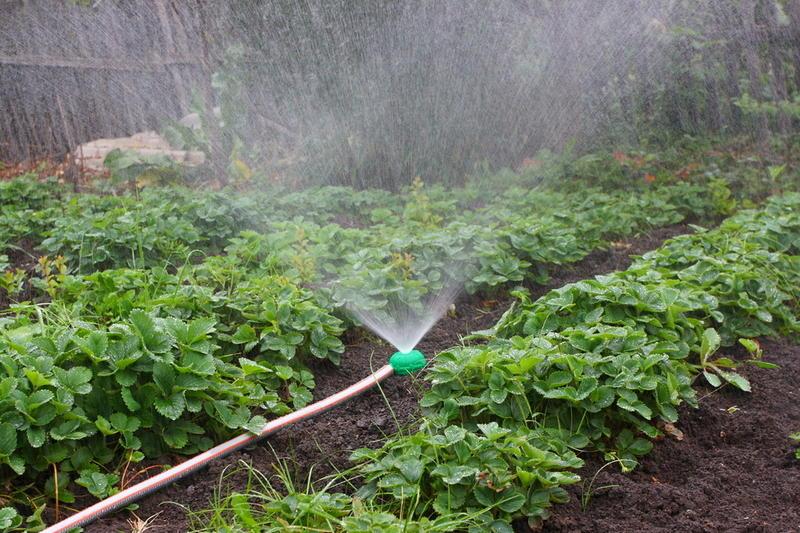
Features of watering by stages of vegetation
There are several stages of watering, focused on different periods of development of the bush:
- Immediately after landing. Planted strawberries will not be able to release flower stalks in the absence of the required concentration of liquid in the soil mixture.
- At the beginning of flowering. The formation of inflorescences, ovaries, fruiting depend on the observance of the "drinking regime".
- When berries appear, fruiting. If there is not enough watering, there will be no harvest. This is an axiom.
The stages differ in the amount of moisture distributed, in doses for each day. It is allowed to combine fertilization and watering, but it is impossible to experiment freely. It is very important to give the strawberries as much water as they need, not a milliliter more or less.

Watering at the beginning of the growing season
As soon as the bush is planted in the ground, it immediately needs watering. It is important to choose the correct doses of liquid. Most often, strawberries are planted in spring or autumn, in moderately warm weather, so you should not be too zealous with water. Be sure to direct the jet at the root, not at the top. The recommended dose is 500 milliliters per shrub for 14 days. The water should be warm.
Subsequently, hardened seedlings receive up to 12 liters of feed per square meter of planting.
The type of soil (sandy, loamy) also affects the maintenance of the moisture level, the amount of water received by the bush. It is important to maintain drainage in the soil. This requires loosening, which allows the root of the plant to receive moisture and air. Get rid of weeds at the same time.

Bloom
The flowering period should be accompanied by dosed watering. Otherwise, general depletion of the plant, problems with fruiting cannot be avoided. The average displacement per one square meter of the plantation is up to 25. The specific amount varies depending on the type of soil, climatic zone, weather. The average depth of moisture penetration into the ground is 25 centimeters.
Mulching between the rows of strawberries will help keep the nutrient fluid in the soil. This step helps to solve 2 problems:
- avoid the development of weeds;
- isolate inflorescences, buds and fruits from contact with moisture (prevent rot).
In August, in autumn, watering is gradually reduced. If the weather is rainy, with regular precipitation, then the amount of moisture is proportionally adjusted. But it is impossible to completely abandon watering so that the plant continues to develop. After all, it is now that a new mustache is being released.

Fruiting
The beginning of the collection of fruits takes place in June, but at this the successful development of events may stop if you do not use growth stimulants, regulated watering in the open field. The secret to successfully obtaining not one, but several harvests, is to comply with the rule of "25 liters of water per square meter."
But it works for hot weather with low humidity in the atmosphere and soil.
The latter indicator is set depending on the type of soil: in mixtures with sand - 70%, in loamy substrates - 80%. The moisture requirement of flower rosettes increases during the formation of ovaries. Creation of a special “channel” in the aisle will help preserve water, preventing the inflorescences from contact with it during the ripening of berries.
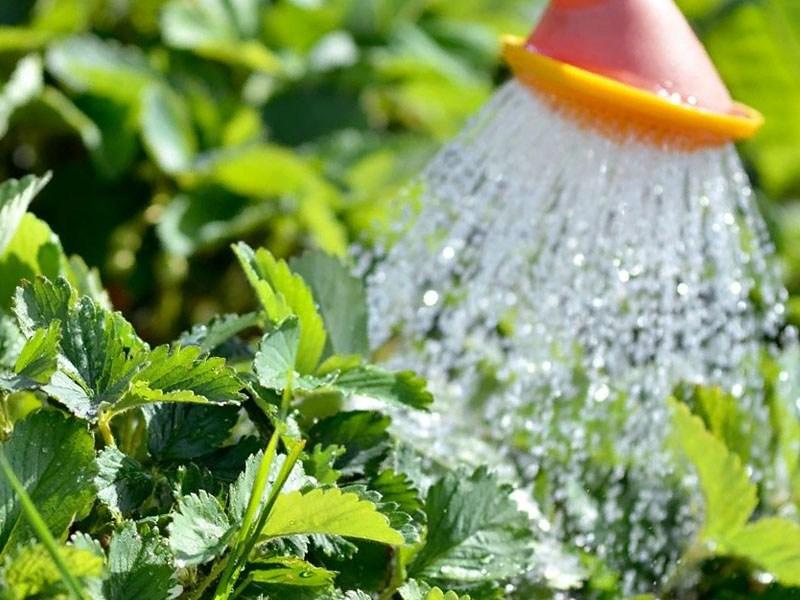
After harvest
Strawberry is one of the crops that does not stop watering after fruiting. This is the care of the berry. Together with top dressing, it allows you to streamline the results, continue harvesting in the future.
First, pruning, removal of old fragments, and plant formation are carried out. Then fertilizer is applied. Watering should be infrequent, but regular, so that the soil on which the bushes grow does not dry out. The more young leaves appear during this period, the better for strawberries: they will protect the bush during wintering, help the plant to endure the cold.
Drip systems
For those who do not want (or cannot) systematically water each bush, dosing the amount of liquid received, there is an alternative solution. It is about drip irrigation technology.

The undoubted merit of the method is as follows:
- The strawberries receive the required amount of moisture.
- A dry layer of soil does not appear on the ground around the bushes.
- Waterlogging does not occur.
Drip irrigation, so named because the water is supplied to the plant in precisely calculated quantities (drop by drop), is recommended for beginners and experienced gardeners. It is easy to make it both from ready-made kits and independently.
The basis of the system is a pump that pumps water through a network of capillaries. Another benefit is delivering life-giving moisture to where it is needed (to the roots). Leaves, inflorescences remain dry. The pollen is not washed off, the plant does not get sunburn. This installation allows you to quickly and efficiently manage strawberry feeding, almost without human intervention. Fresh seedlings, deepened into the ground and protected by a covering material from temperature changes, will be able to receive adequate nutrition, will grow faster if drip irrigation is provided.
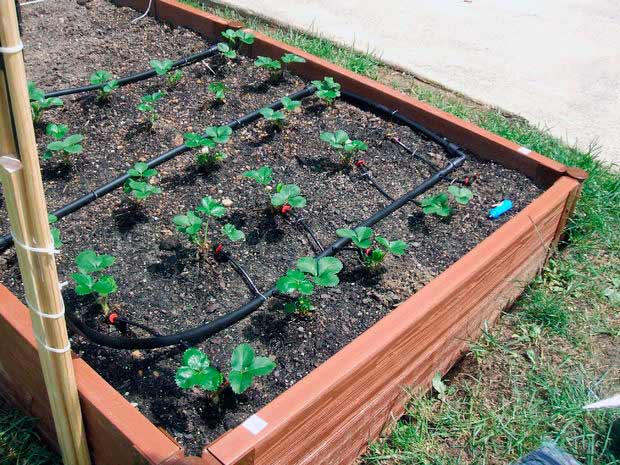
The system is simple in design but extremely effective. It is enough to familiarize yourself with the principle of its operation once to create the same one on your personal plot. Moreover, components (hoses, pump, adapters) are easy to buy in a store or on the market.
Sprinkler irrigation systems
Each guide to growing strawberries, experienced gardeners place special emphasis on watering. This aspect extends to timeliness, fluid volumes and distribution area. It is equally important to find a balance between “pour, bring to rot” and “do not top up, allow an airtight crust to form”.
The task is made easier by using irrigation systems. These include drip irrigation, structures with water spray over the parsing area. To understand the difference and common features of these options, it is enough to compare them:
| A type | Drip system | Sprinkler design |
| Features: | Flexible capillaries with holes are used. The pump pumps the water evenly to the strawberry roots. The flow rate and head can be adjusted. Liquid feed from the bottom | A special movable unit is used to spray water. Automation is allowed to deliver a metered amount of moisture to each strawberry bush. Liquid feed from above |
| Benefits | There is no need for human presence. The system ensures the supply of nutrient fluid to the strawberry bushes | |
| disadvantages | Requires a large number of hoses, capillary routing and communication of parts | If the adjustment is incorrect, it is possible to flood bushes, berries, develop rot |

In fact, a spray nozzle is a special nozzle that creates a thin, almost imperceptible stream of water. At the same time, consumption is minimized, an even distribution of liquid over the area of the strawberry plantation is ensured. Assembling such a system with your own hands is easier than others. In the future, automation can be added to the design in order to free yourself from the need to worry about watering strawberries, getting a stable harvest of berries.
Newbie mistakes
No one is immune from mistakes. But most often they happen to beginners. This is natural, since experience and knowledge, and sometimes attentiveness, understanding of the essence of phenomena is lacking. Mistakes happen when choosing where to plant strawberries. This is a low, swampy place, poor (with low permeability) soil, lack of nutrients that the seedling will need to grow.
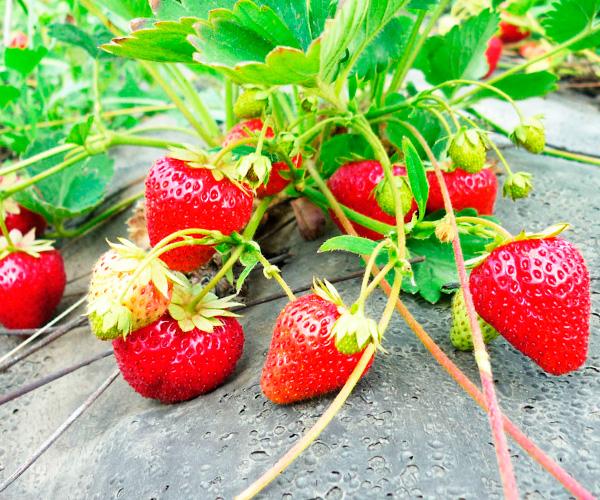
Depending on the severity of the problem, different methods of solution are used: transplantation, replacement of the earth mixture, the use of organic (mineral) fertilizers.
The next mistake concerns the wrong watering regime. There are 2 options here - excessive and insufficient. In the first case, the bushes will begin to rot, the berries will disappear, turn gray, the crop will be spoiled. In the second, the strawberries will dry out and develop poorly. The third mistake is related to neglecting strawberry pruning. And completely in vain. The abundance of the whiskers released draws juices from the bush, strawberries are deprived of the necessary nutrients, minerals and moisture.
Another blunder is due to placing high hopes on irrigation systems: they are automatic, they will cope with everything themselves. Both drip and spray designs must be adjusted, adjusted depending on the weather, season, specific situation. Only in this case will they supply the strawberry bushes with life-giving liquid, preventing waterlogging.
And one moment. The water should not be cold. It is better to use a special container (sump) in which the liquid for watering strawberries naturally heats up.

